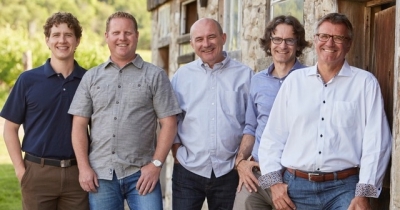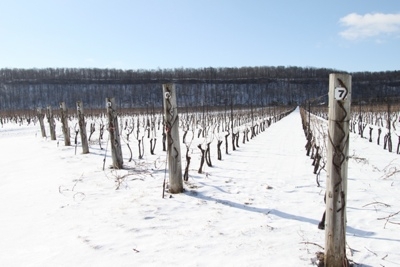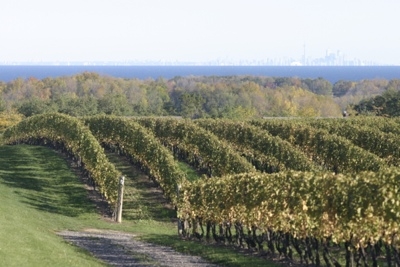CAVE SPRING VINEYARD, Jordan
Almost 50 years ago, the Pennachetti family — Len and his father John, Sr. — helped pioneer the cultivation of European grape varietals on the Niagara Peninsula. The site that was to become Cave Spring Vineyard was purchased in 1973, and planted with some of the region’s first Riesling & Chardonnay vines between 1974 and ’78. Named by 18th century European settlers for the limestone caves and mineral springs located throughout the property, situated on a gently sloping hillside at the heart of a narrow 8 km terrace of the Niagara Escarpment known as the Beamsville Bench, the site offered significant potential for quality winegrowing. These original blocks now represent some of Niagara's oldest vinifera plantings — the Chardonnay and Riesling reserved for Cave Spring’s iconic ‘CSV’ bottlings.
The winery was founded in 1986 by the Pennachetti family and winemaker Angelo Pavan in the historic former Jordan Winery, with cellars dating to 1871. By the time Cave Spring celebrated its 25th anniversary in 2011, it was firmly established as one of Canada’s most acclaimed wineries, earning a reputation for crafting elegant and distinctive cool-climate wines in the heart of Ontario’s wine country. In 2014, Ian D’Agata (Vinous, Decanter, Stephen Tanzer’s International Wine Cellar), recognized Cave Spring as “arguably Canada’s best winery”.
It would be easy for Cave Spring to coast. These are some of the most consistently high-quality wines produced in Canada – one of the few Canadian wineries to be consistently invited to participate in Wine Spectator Magazine’s series of Grand Tour tastings, as well as being named to Wine & Spirit Magazine’s Top 100 Wineries of 2018, and a Wine Enthusiast magazine ‘Wine Star’ nomination for New World Winery of the Year. But coasting is not in their nature. Working hand in hand with winemaker Angelo Pavan, oenologist & viticulturalist Gabriel DeMarco brings a complementary perspective to the vineyards and cellar from his formal training at Brock University’s Oenology & Viticulture program. Angelo is Canada’s longest-tenured winemaker and highly influential in the country’s dynamic wine scene. Something of a philosopher (in part by graduate-level academic training) and historian, Angelo is without question one of the country’s most important winemakers.
Constantly improving, Cave Spring has a long tradition of experimentation, often in cooperation with Brock University’s Cool Climate Oenology and Viticulture Institute (CCOVI). Research on rootstock and clones (Cabernet Franc and other varieties) has continued for many years. Vineyard management is an ongoing passion; constantly improving methods to ensure fruit is healthy, yields are optimized for quality, and the best varieties are grown for the region and climate. Experiments with indigenous yeast fermentations began in in 2004, but were established on an on-going basis in 2010, and now over 90% of Cave Spring’s bottlings are vinified using indigenous yeast. In the cellar, the evolution includes a move over the past decade to a barrel regime that includes 97% neutral, old oak, half of which is in large formats ranging from 500 to 4,000L; extended lees contact; skin-contact for white wines; and whole berry fermentation and stem contact for the reds. This is truly a leading-edge estate, working with artisanal techniques not just for its premium bottlings, but for the full range of wines.
As Niagara's only hillside, the Escarpment prevents frost damage in benchland vineyards during winter and spring by trapping warm air released from Lake Ontario. In the summer months, the Bench benefits from cool lake-effect breezes, which, as they circulate along its slopes, discourage harmful mildews. And during autumn, warm lake air displaces cool air as it descends from the Escarpment crest, thereby extending the ripening season. The Beamsville Bench's hillside exposure furnishes excellent natural drainage, which forces vine roots to search deep into mineral-rich clay/loam soils for moisture. This serves to reduce yields and improve the concentration and complexity of flavour in the fruit. Cave Spring Vineyard is planted at densities of up to 4,000 vines per hectare, almost twice Niagara's norm. Cave Spring Beamsville Bench wines embody the highest commitment to the terroir of this, perhaps the region’s most prestigious sub-appellation. In addition to the 55 ha Cave Spring Vineyard, the winery farms the 8.5 ha Meyers Vineyard (planted to Weis 21 Riesling clone), and 3 ha Tufford Road Vineyard, both in the Lincoln Lakeshore sub-appellation.
Estate vineyards furnish over 90% of the winery’s grape supply, with the remaining 10% purchased from Andrewes Vineyard, also in the Lincoln Lakeshore, which is owned by Chris Andrewes, the vineyard manager for all the winery’s vineyards. Overall, 80% of the grape supply originates from the Beamsville Bench and 20% from the Lincoln Lakeshore. Within the portfolio of wines, the various tiers are identified by origin:
- The entry-level VQA Niagara Peninsula wines are 80% Estate Grown on average, blended from Cave Spring, Tufford Road and Andrewes vineyards.
- The VQA Niagara Escarpment wines are 100% Estate Grown from Cave Spring Vineyard proper, as are the VQA Beamsville Bench Dolomite wines.
- At the pinnacle of the portfolio are a handful of proprietary, VQA Beamsville Bench bottlings from Cave Spring’s top, old-vine parcels at Cave Spring Vineyard, including the iconic CSV Riesling, CSV Chardonnay and CSV Blanc de Blancs, as well as the Riesling Adam Steps and La Penna Cabernet Franc. These wines embody the winery’s highest commitment to the terroir of Cave Spring Vineyard, having established themselves as flag bearers for quality winegrowing in the Niagara Peninsula as a whole.
Cave Spring was Ontario’s first Certified Sustainable winery, under Sustainability Winemaking Ontario (SWO). Over and above SWO minimum standards, Cave Spring is a regional leader in applying organic methods in the vineyards, including biological root, vineyard floor and canopy management treatments in addition to biodiversity initiatives aimed at controlling pests and mechanical weed control. In the cellars, a globally innovative waste-water treatment system, extensive use of lightweight glass and cork closures, and environmentally sustainable label printing support this commitment. You can find complete information on the winery website. Cave Spring wines are Vegan-friendly.



